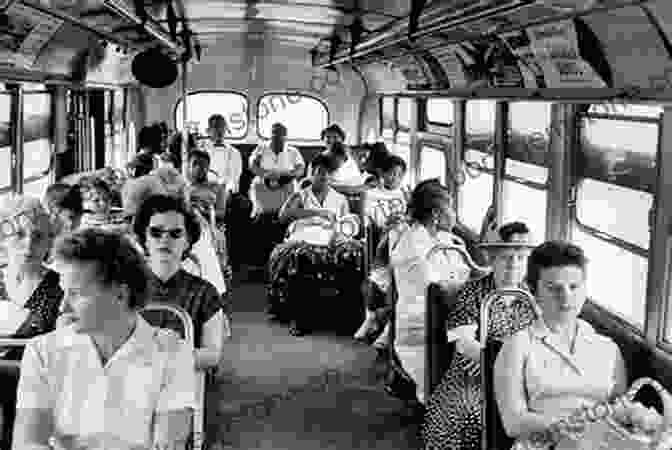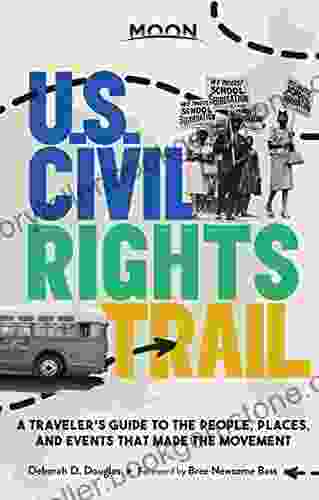Colored Seated In The Rear: A History of Racial Segregation on Public Transportation


Racial segregation has been a pervasive feature of American society for centuries. From the institution of slavery to the Jim Crow era, laws and social customs have enforced the separation of black and white people in all aspects of life, including transportation.
5 out of 5
| Language | : | English |
| File size | : | 3831 KB |
| Text-to-Speech | : | Enabled |
| Screen Reader | : | Supported |
| Enhanced typesetting | : | Enabled |
| Word Wise | : | Enabled |
| Print length | : | 178 pages |
| Lending | : | Enabled |
One of the most visible and humiliating forms of segregation was the practice of requiring black passengers to sit in the back of public transportation vehicles. This practice, known as "Colored Seated In The Rear," was widespread throughout the United States from the late 19th century until the mid-20th century.
The Origins of Segregation on Public Transportation
The origins of racial segregation on public transportation can be traced back to the post-Reconstruction era. Following the Civil War, black Americans gained citizenship and the right to vote, but they continued to face discrimination and violence. In response to this, black leaders began to organize and advocate for their rights.
One of the key demands of the black community was the right to ride public transportation on an equal basis with white people. However, white supremacists resisted this demand, and they began to pass laws requiring black passengers to sit in separate sections of public transportation vehicles.
The Spread of Segregation
The practice of "Colored Seated In The Rear" quickly spread throughout the United States. By the turn of the 20th century, it was common practice in most southern states and many northern cities.
The enforcement of segregation on public transportation was often brutal. Black passengers who refused to sit in the back of the bus or train were often arrested, beaten, or even killed.
The Challenge to Segregation
The practice of "Colored Seated In The Rear" was not without its challengers. Throughout the 20th century, black activists and their white allies fought to end segregation on public transportation.
One of the most famous challenges to segregation was the Montgomery Bus Boycott. In 1955, Rosa Parks, a black woman, refused to give up her seat to a white passenger on a bus in Montgomery, Alabama. Her arrest sparked a year-long boycott of the city's buses by black residents. The boycott was successful, and it led to the desegregation of public transportation in Montgomery.
The Montgomery Bus Boycott was a turning point in the civil rights movement. It showed that black people were no longer willing to tolerate segregation, and it inspired other cities to follow Montgomery's lead.
The End of Segregation
In 1964, the Civil Rights Act was passed, which outlawed segregation in all public accommodations, including public transportation. This law finally ended the practice of "Colored Seated In The Rear."
However, the legacy of segregation continues to this day. Black people are still more likely to experience discrimination and violence on public transportation than white people.
The practice of "Colored Seated In The Rear" was a shameful chapter in American history. It was a system of legalized discrimination that denied black people their basic rights.
The end of segregation was a major victory for the civil rights movement. However, the legacy of segregation continues to this day, and we must all work to create a more just and equitable society for all.
5 out of 5
| Language | : | English |
| File size | : | 3831 KB |
| Text-to-Speech | : | Enabled |
| Screen Reader | : | Supported |
| Enhanced typesetting | : | Enabled |
| Word Wise | : | Enabled |
| Print length | : | 178 pages |
| Lending | : | Enabled |
Do you want to contribute by writing guest posts on this blog?
Please contact us and send us a resume of previous articles that you have written.
 Best Book
Best Book Page Flip
Page Flip Bookshelf
Bookshelf Literary loom
Literary loom Chapter
Chapter Bookish
Bookish PageTurner
PageTurner Bibliophile
Bibliophile Story
Story Inkwell
Inkwell Bookworm
Bookworm Labyrinth
Labyrinth Plot Twist
Plot Twist Prose
Prose Paperback
Paperback Storyteller
Storyteller Sanctuary
Sanctuary Fiction
Fiction Reading
Reading Chronicle
Chronicle Read
Read Ariana Godoy
Ariana Godoy Mark Baskinger
Mark Baskinger Sheila O Flanagan
Sheila O Flanagan Michael Kimmelman
Michael Kimmelman Anwei Skinsnes Law
Anwei Skinsnes Law Colby Buzzell
Colby Buzzell Aziz Shihab
Aziz Shihab Avery Blake
Avery Blake Madeleine Walker
Madeleine Walker Mary Kay Ricks
Mary Kay Ricks Joseph Wambaugh
Joseph Wambaugh Michael Tucker
Michael Tucker S H Jucha
S H Jucha Myrnoska Scott
Myrnoska Scott John Scarne
John Scarne Emma Read
Emma Read Satyajit Ray
Satyajit Ray Bernadette Murphy
Bernadette Murphy Obed Silva
Obed Silva Brian Butko
Brian Butko John Triptych
John Triptych Anne Moody
Anne Moody Mark Edward Harris
Mark Edward Harris Ray Bradbury
Ray Bradbury Jeffrey Vonk
Jeffrey Vonk Sarah Crafts
Sarah Crafts Elena M Watson
Elena M Watson Jesse Martin
Jesse Martin Valerie Mckeehan
Valerie Mckeehan Jason Louis
Jason Louis Nora Roberts
Nora Roberts Francesca Fiorani
Francesca Fiorani Austin Howe
Austin Howe Ashley Mahlberg
Ashley Mahlberg Scott M Madden
Scott M Madden Anne Keenan Higgins
Anne Keenan Higgins Patrick Rothfuss
Patrick Rothfuss Smauggy Universe
Smauggy Universe Ayn Rand
Ayn Rand Anne Rice
Anne Rice Marina Garone Gravier
Marina Garone Gravier Julie Nelson Davis
Julie Nelson Davis Carolyn Jenkins
Carolyn Jenkins Deborah Paris
Deborah Paris Robert Graysmith
Robert Graysmith Haben Girma
Haben Girma Clive Hallett
Clive Hallett Steven Bradley
Steven Bradley Ashley Bristowe
Ashley Bristowe Ron Stocke
Ron Stocke Aubrey A Jones
Aubrey A Jones Nicholas Sansbury Smith
Nicholas Sansbury Smith Nancy Lee Mccaskill
Nancy Lee Mccaskill Jose Antonio Salgado Alonso
Jose Antonio Salgado Alonso Woody Allen
Woody Allen Bwwm Love
Bwwm Love Jun Maeda
Jun Maeda Armin Weber
Armin Weber Brian W Smith
Brian W Smith Michael Betancourt
Michael Betancourt Kindle Edition
Kindle Edition Arlo Adams
Arlo Adams Annemarie Strehl
Annemarie Strehl Mackinley Helm
Mackinley Helm Haruki Murakami
Haruki Murakami Stephan Talty
Stephan Talty Tiffany Roberts
Tiffany Roberts Geoff Schumacher
Geoff Schumacher Tracy Birdsall
Tracy Birdsall John H Clark Iii
John H Clark Iii Marta Mcdowell
Marta Mcdowell Hanife Hassan O Keeffe
Hanife Hassan O Keeffe Christopher Sieving
Christopher Sieving John H Groberg
John H Groberg Hannah Arendt
Hannah Arendt Anthony C Winkler
Anthony C Winkler Meyer Berger
Meyer Berger Jan Cohen Cruz
Jan Cohen Cruz Tamron Hall
Tamron Hall Joseph Birchall
Joseph Birchall Jane Sullivan
Jane Sullivan Kalyn Franke
Kalyn Franke Tara Wells
Tara Wells Anthony J Melchiorri
Anthony J Melchiorri Maria Venegas
Maria Venegas Nicole Casey
Nicole Casey Zharel Anger
Zharel Anger Anthony Ryder
Anthony Ryder Sarah Winnemucca Hopkins
Sarah Winnemucca Hopkins Ansel Adams
Ansel Adams Walt Bachman
Walt Bachman Catherine E Mckinley
Catherine E Mckinley Arthur C Danto
Arthur C Danto Anton Hager
Anton Hager Joe Abercrombie
Joe Abercrombie Debbie Macomber
Debbie Macomber Tamar Diana Wilson
Tamar Diana Wilson Scott Westerfeld
Scott Westerfeld J R Osborn
J R Osborn George Bird Grinnell
George Bird Grinnell Laurel Ann Francis
Laurel Ann Francis Linda Nagata
Linda Nagata Yuk Hui
Yuk Hui Jason Frye
Jason Frye Joe Russo
Joe Russo Anne Manera
Anne Manera Arthur Bartow
Arthur Bartow August Wilson
August Wilson Howling Moon Books
Howling Moon Books Anthony James
Anthony James Valerie Biden Owens
Valerie Biden Owens Joan Baxter
Joan Baxter Frank Conroy
Frank Conroy Anne Sebba
Anne Sebba Arthur C Clarke
Arthur C Clarke George Huppert
George Huppert Chris A Norton
Chris A Norton W Michael Blumenthal
W Michael Blumenthal Edgar Rice Burroughs
Edgar Rice Burroughs Robert V Camuto
Robert V Camuto Miss Jenesequa
Miss Jenesequa Barbara Demarco Barrett
Barbara Demarco Barrett Peter Turchi
Peter Turchi Pearl Howie
Pearl Howie Luke Nguyen
Luke Nguyen Vladimir London
Vladimir London Gina Rossi Armfield
Gina Rossi Armfield Tony Hillerman
Tony Hillerman Shugri Said Salh
Shugri Said Salh Elizabeth Bard
Elizabeth Bard Nathan Deuel
Nathan Deuel Howard Dully
Howard Dully Noy
Noy Wesley B Turner
Wesley B Turner Rob Schmitz
Rob Schmitz R A Lafferty
R A Lafferty Ashley K Stoyanov Ojeda
Ashley K Stoyanov Ojeda Colonial Williamsburg Foundation
Colonial Williamsburg Foundation Anne Mccaffrey
Anne Mccaffrey Oliver Mayes
Oliver Mayes Detlev Henschel
Detlev Henschel B B Thatcher
B B Thatcher Ashley Fiolek
Ashley Fiolek Kim Erwin
Kim Erwin Michael Frank
Michael Frank Bella Martin
Bella Martin Oscar Zeta Acosta
Oscar Zeta Acosta John Woolf
John Woolf Gail Morin
Gail Morin Sadhna Shanker
Sadhna Shanker Samantha Hahn
Samantha Hahn Laura Davis Chanin
Laura Davis Chanin Shonda Buchanan
Shonda Buchanan Shami Stovall
Shami Stovall Owen Jones
Owen Jones Katja Pantzar
Katja Pantzar Rebecca Keegan
Rebecca Keegan Christine Denniston
Christine Denniston John Davidson
John Davidson Vanessa Hua
Vanessa Hua Maxine Leeds Craig
Maxine Leeds Craig B V Larson
B V Larson Tony Randgaard
Tony Randgaard Chris Saper
Chris Saper Heather Vogel Frederick
Heather Vogel Frederick Gloria Mattioni
Gloria Mattioni Atsons
Atsons Zeneba Bowers
Zeneba Bowers John A Crespi
John A Crespi Asali Solomon
Asali Solomon Caroline Montague
Caroline Montague Sari Botton
Sari Botton John Izbicki
John Izbicki John E Siers
John E Siers Richard Pikesley
Richard Pikesley Philip Tyler
Philip Tyler James Rosone
James Rosone W A Bentley
W A Bentley Doug Peterson
Doug Peterson Tim Gunn
Tim Gunn Antony Kamm
Antony Kamm D Levesque
D Levesque Ernst Lehner
Ernst Lehner Rebecca Kaye
Rebecca Kaye Michael Fleishman
Michael Fleishman Antonia Fraser
Antonia Fraser Regina Held
Regina Held Br Kingsolver
Br Kingsolver Lorna Luft
Lorna Luft Doug Scott
Doug Scott Pat Hall
Pat Hall Joan Bess
Joan Bess Vernor Vinge
Vernor Vinge Dennic Chunman Lo
Dennic Chunman Lo Ar Corbin
Ar Corbin Christopher Simmons
Christopher Simmons Scott Hughey
Scott Hughey Chris Cozen
Chris Cozen Austin Channing Brown
Austin Channing Brown Chris Weyers
Chris Weyers Kirsten Anderson
Kirsten Anderson Brendan Edwards
Brendan Edwards M N Forgy
M N Forgy Linda Furiya
Linda Furiya Tracy Franz
Tracy Franz Axel Hacke
Axel Hacke Anton Tekshin
Anton Tekshin B Russell Mcconkie
B Russell Mcconkie Charles Taliaferro
Charles Taliaferro Kathy Kolbe
Kathy Kolbe Franklin Horton
Franklin Horton Arne Dehli
Arne Dehli Antoinette Nora Claypoole
Antoinette Nora Claypoole Anne Morrow Lindbergh
Anne Morrow Lindbergh Talia Beckett
Talia Beckett James D Umbach
James D Umbach Kyunghee Pyun
Kyunghee Pyun Edgar Degas
Edgar Degas Joseph Mcbride
Joseph Mcbride Rebecca Serle
Rebecca Serle Todd Barry
Todd Barry Jan Murphy
Jan Murphy Jonathan Strahan
Jonathan Strahan Avanti Centrae
Avanti Centrae Anne Lister
Anne Lister Lutishia Lovely
Lutishia Lovely Richard Killeen
Richard Killeen Billy Connolly
Billy Connolly Peter James West
Peter James West Beata Lubas
Beata Lubas Cynthia Winton Henry
Cynthia Winton Henry Matthew Jm Carpenter
Matthew Jm Carpenter Jay Boyce
Jay Boyce Annette Dozier
Annette Dozier Chloe Fox
Chloe Fox Diana Kupershmit
Diana Kupershmit Annemarie Bean
Annemarie Bean Michael Jan Friedman
Michael Jan Friedman Kaitlyn Greenidge
Kaitlyn Greenidge Doris Marjorie Moore
Doris Marjorie Moore Carne Griffiths
Carne Griffiths Lou Sutton
Lou Sutton George Rathmell
George Rathmell Gayatri Gopinath
Gayatri Gopinath David E Stannard
David E Stannard Maureen T Corrigan
Maureen T Corrigan Jennifer Homans
Jennifer Homans Pamela Des Barres
Pamela Des Barres Suzanne Fredericq
Suzanne Fredericq Keller Easterling
Keller Easterling Saeed Jones
Saeed Jones Olive Collins
Olive Collins Fifi O Neill
Fifi O Neill Elizabeth Friendship
Elizabeth Friendship Darby English
Darby English Wakefield Poole
Wakefield Poole Lian Hearn
Lian Hearn David Deal
David Deal Davida Schulman
Davida Schulman Armine Von Tempski
Armine Von Tempski Arielle Eckstut
Arielle Eckstut Anthony Ryan
Anthony Ryan Jay Allan
Jay Allan Phil Doran
Phil Doran Jt Sawyer
Jt Sawyer Ashlee Vance
Ashlee Vance Zalmay Khalilzad
Zalmay Khalilzad Karl Ove Knausgaard
Karl Ove Knausgaard Elise Darcy
Elise Darcy Pankaj Mishra
Pankaj Mishra Tim Z Hernandez
Tim Z Hernandez Kris Jenner
Kris Jenner Anne Frank
Anne Frank Patricia Williams
Patricia Williams Leokadia Schmidt
Leokadia Schmidt Steven M Nolt
Steven M Nolt Ruth Wariner
Ruth Wariner Anthony Slide
Anthony Slide Scott Lerman
Scott Lerman Tim Downs
Tim Downs Margaret Walker
Margaret Walker Carl Stubblefield
Carl Stubblefield Angela Y Davis
Angela Y Davis Arthur Murray
Arthur Murray Rosemary Sullivan
Rosemary Sullivan Ursa Dax
Ursa Dax Annie Keary
Annie Keary Michael Chatfield
Michael Chatfield Karen A Romanko
Karen A Romanko Pat Cadigan
Pat Cadigan Arthur Miller
Arthur Miller De Andrea
De Andrea Avery Grey
Avery Grey Peter F Hamilton
Peter F Hamilton King Ellie
King Ellie Prenisha Aja
Prenisha Aja Mary Maccracken
Mary Maccracken Sue Miller
Sue Miller Dirk Hayhurst
Dirk Hayhurst Anton Roux
Anton Roux Waldo Rodriguez
Waldo Rodriguez Pico Iyer
Pico Iyer Sara Paretsky
Sara Paretsky Asaf Messerer
Asaf Messerer Xiaolu Guo
Xiaolu Guo Mimi Kwa
Mimi Kwa Yasmin Angoe
Yasmin Angoe Annette Freeman
Annette Freeman Robert Dugoni
Robert Dugoni Benjamin Percy
Benjamin Percy R G Collingwood
R G Collingwood Karen Ordahl Kupperman
Karen Ordahl Kupperman Gene D Phillips
Gene D Phillips Lonely Planet
Lonely Planet Antonis Tsagaris
Antonis Tsagaris Riva Lehrer
Riva Lehrer Koji A Dae
Koji A Dae Julian Stallabrass
Julian Stallabrass Deborah D Douglas
Deborah D Douglas Jasper T Scott
Jasper T Scott Ken Seeroi
Ken Seeroi Juliette Sobanet
Juliette Sobanet Beverly Galeskas
Beverly Galeskas Stephen Moss
Stephen Moss Colin Angus
Colin Angus Eric Broudy
Eric Broudy Jane Monteith
Jane Monteith Annette Gordon Reed
Annette Gordon Reed New Edition Kindle Edition
New Edition Kindle Edition Erin Eitter Kono
Erin Eitter Kono Stewart James
Stewart James Eugenio Barba
Eugenio Barba Claire Devarrieux
Claire Devarrieux Bill White
Bill White Cathy Curtis
Cathy Curtis Michael Evamy
Michael Evamy Eileen Mcnamara
Eileen Mcnamara Ashley Jaquavis
Ashley Jaquavis Joan Tollifson
Joan Tollifson Anthea Sharp
Anthea Sharp Laurence Oliphant
Laurence Oliphant Jane Yolen
Jane Yolen Edward Achorn
Edward Achorn Jim Steinmeyer
Jim Steinmeyer Lena Grey
Lena Grey Annie Ernaux
Annie Ernaux Fergal Keane
Fergal Keane Clare Therese Gray
Clare Therese Gray Marlene Wagman Geller
Marlene Wagman Geller Anthony Jones
Anthony Jones Rivers Solomon
Rivers Solomon Jay Caspian Kang
Jay Caspian Kang Dave Bartell
Dave Bartell Karen Mccartney
Karen Mccartney Ashley Brantley
Ashley Brantley Bear Heart
Bear Heart B Ruby Rich
B Ruby Rich Annemieke Mein
Annemieke Mein Martin Cruz Smith
Martin Cruz Smith Anne Richardson Williams
Anne Richardson Williams Robert J Serling
Robert J Serling Beth Haslam
Beth Haslam Robert D Kaplan
Robert D Kaplan Jason Waguespack
Jason Waguespack Elizabeth David
Elizabeth David Chawadee Nualkhair
Chawadee Nualkhair David Consuegra
David Consuegra Jodi Ohl
Jodi Ohl Anthony M Amore
Anthony M Amore Jaime Castle
Jaime Castle Donald Murray
Donald Murray David Larocca
David Larocca Anthony M Strong
Anthony M Strong Peter Watts
Peter Watts Approach Guides
Approach Guides Mary Renault
Mary Renault N L Hudson
N L Hudson Lydia Wilen
Lydia Wilen Paul Steinberg
Paul Steinberg Magi Nams
Magi Nams Janet Farnsworth
Janet Farnsworth James Maskalyk
James Maskalyk Arthur Conan Doyle
Arthur Conan Doyle Anton Treuer
Anton Treuer Annette Insdorf
Annette Insdorf Betty Reynolds
Betty Reynolds Eric Campbell
Eric Campbell Berlitz Publishing
Berlitz Publishing Sarah Vallance
Sarah Vallance Ava Archer
Ava Archer Jan Morris
Jan Morris Kevin Mannens
Kevin Mannens Annette Kowalski
Annette Kowalski Jean Guerrero
Jean Guerrero Martin Kemp
Martin Kemp Anne Hillerman
Anne Hillerman Ashleynicole
Ashleynicole Arleta Pech
Arleta Pech Margaret Scott
Margaret Scott Arthur H Buckley
Arthur H Buckley Lizzie Williams
Lizzie Williams Arielle Silverman Ph D
Arielle Silverman Ph D Kristen Ashley
Kristen Ashley Paul Holt
Paul Holt Ashley Antoinette
Ashley Antoinette Quentin Tarantino
Quentin Tarantino Blaze Ward
Blaze Ward Charles Nordhoff
Charles Nordhoff Tay Mo Nae
Tay Mo Nae Wade Motawi
Wade Motawi Christopher Griffin
Christopher Griffin Mary Ann Scott
Mary Ann Scott Binka Le Breton
Binka Le Breton T R Todd
T R Todd S C Jensen
S C Jensen Kim Knox
Kim Knox Tony Peak
Tony Peak Nnedi Okorafor
Nnedi Okorafor Art Wolfe
Art Wolfe Tia Williams
Tia Williams Paul Brinkley Rogers
Paul Brinkley Rogers Pamela Cutter
Pamela Cutter Ariel Dorfman
Ariel Dorfman Fig Taylor
Fig Taylor Bob Mayer
Bob Mayer Kao Kalia Yang
Kao Kalia Yang Asimina Nteliou
Asimina Nteliou Artemisia Gentileschi
Artemisia Gentileschi Arrigo Cipriani
Arrigo Cipriani Destiny Davis
Destiny Davis Lorraine Caputo
Lorraine Caputo Blackhorse Mitchell
Blackhorse Mitchell Anton Chekhov
Anton Chekhov Matthew A Goodwin
Matthew A Goodwin Eric Warren
Eric Warren Anne Green Gilbert
Anne Green Gilbert Anthony David
Anthony David H Dolmetsch
H Dolmetsch Anne De Courcy
Anne De Courcy Thomas M Hill
Thomas M Hill Arnold Rampersad
Arnold Rampersad Graham Fraser
Graham Fraser Nick Cole
Nick Cole Morgan Rogers
Morgan Rogers Robert Beverly Hale
Robert Beverly Hale Jacqueline Rayner
Jacqueline Rayner Ari Seth Cohen
Ari Seth Cohen Nancy Nicholson
Nancy Nicholson Peter Jazwinski
Peter Jazwinski Sonia Misra
Sonia Misra Apsley Cherry Garrard
Apsley Cherry Garrard
Light bulbAdvertise smarter! Our strategic ad space ensures maximum exposure. Reserve your spot today!

 Wesley ReedFulcrum Gun Savage Stars: A Comprehensive Guide to the Powerful Energy Weapon...
Wesley ReedFulcrum Gun Savage Stars: A Comprehensive Guide to the Powerful Energy Weapon... Jesus MitchellFollow ·12k
Jesus MitchellFollow ·12k Ruben CoxFollow ·7.4k
Ruben CoxFollow ·7.4k George Bernard ShawFollow ·7.9k
George Bernard ShawFollow ·7.9k Jimmy ButlerFollow ·16.2k
Jimmy ButlerFollow ·16.2k Benji PowellFollow ·12.6k
Benji PowellFollow ·12.6k Ivan CoxFollow ·9.2k
Ivan CoxFollow ·9.2k Dwight BlairFollow ·4.9k
Dwight BlairFollow ·4.9k Davion PowellFollow ·10.9k
Davion PowellFollow ·10.9k

 Braden Ward
Braden WardMade to Order Robots and the Coming Revolution
Robots are becoming increasingly common...

 Clay Powell
Clay Powell1971: A Year in the Life of Color
The year 1971 was a pivotal one for color....

 Ralph Waldo Emerson
Ralph Waldo EmersonTech World's Undying Mercenaries: A Deep Dive into the...
In the ever-evolving landscape of the...

 Wade Cox
Wade CoxThe Ultimate Traveler's Guide to the People, Places, and...
Travel has always been a part of the human...

 Evan Simmons
Evan SimmonsA Comprehensive Guide: Uncovering Small Town Culinary...
: A Culinary Odyssey Beyond the City...
5 out of 5
| Language | : | English |
| File size | : | 3831 KB |
| Text-to-Speech | : | Enabled |
| Screen Reader | : | Supported |
| Enhanced typesetting | : | Enabled |
| Word Wise | : | Enabled |
| Print length | : | 178 pages |
| Lending | : | Enabled |












